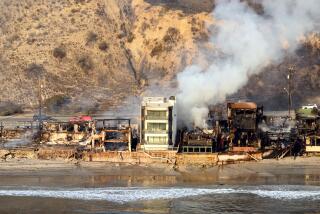THE LOS ANGELES EARTHQUAKE : About 60 Structures Found ‘Unsafe’ So Far : Building Inspectors Put In Overtime
- Share via
By mid-morning Friday, Joe Velasquez had posted a red-and-white “Unsafe Building Do Not Enter” sign for the third time since the earthquake struck.
This one was a four-story apartment building on Wilshire Boulevard in the MacArthur Park area, with paint peeling off the front. A “Now Renting” sign still hung from the door. “The floors separated from the walls. It’s an old brick building,” said the husky, 30-year-old inspector for the Los Angeles Building and Safety Department.
Velasquez headed back to City Hall to get his next batch of inspection orders issued in response to more than 500 calls that had come in from homeowners and businessmen worried about cracks in walls, floors and ceilings.
He will be on overtime today and probably Sunday as well, or “until it’s done and we can go back to normal,” said Jim Carney, principal building and safety inspector, who has been routing 75 city inspectors since the earthquake. “We pulled everybody off their regular inspections and put them on this.”
The same has been true of dozens of inspectors in other areas, who have been putting in long hours to meet the demand. In hard-hit Whittier, the city’s eight inspectors were augmented by 20 more sent over by the city and county of Los Angeles and the City of Rancho Cucamonga to field at least 1,200 inspection requests.
Alhambra doubled its inspection team to six and put them on 10-hour days, a city spokesman said, probably through the weekend. Pasadena increased its inspection team from five to 10, and Los Angeles County, according to Don Wolf, superintendent of building and safety, assigned 30 inspectors to check structures in East Los Angeles, the unincorporated sections of Whittier, Norwalk and Commerce.
By late Friday, city inspectors in Los Angeles had seen about 500 commercial, residential or industrial buildings. So far most inspections have been the result of citizen requests, Carney said. Of those checked, about 60 have been declared unsafe, but he could not say how many residents or businesses have been displaced.
Carney added that the city’s entire stock of 7,000 unreinforced pre-1933 buildings, considered the most vulnerable to earthquake damage, will also be inspected.
Like most other inspectors, Velasquez was already at work by the time the earthquake hit. “We went for cover,” he recalled. “But as soon as it happened, we knew we were going to be out on emergency calls.”
Velasquez spent the rest of Friday checking reports of bulging walls, cracked floors and cracking plaster in one apartment and various offices. He found none of the damage serious.
Clad in jeans and sneakers, armed with a flashlight, “emergency inspection” forms and “Unsafe” signs ready for posting, he stopped at 118 Winston St. on Skid Row. A man in ragged clothes slept in the doorway outside.
Inside, Marian Zucco, director of United American Indian Involvement, a service center for Native Americans, had been waiting anxiously. “I haven’t wanted to let anyone come in,” she said.
Several cracks appeared Thursday in the building in which earthquake reinforcement had just been completed this summer, she said.
“There’s a good chance this building is standing today because of that,” Velasquez said. He walked around the outside of the building, scanning the sides for cracks, then through each of the center’s three floors while Zucco pointed out the cracks.
Like people at all his stops, Zucco told him where she had been when the quake hit. “There was a lot of shaking,” she said.
“I bet there was,” Velasquez said, as he had dozens of times before. He flicked his flashlight along the ceiling borders while he spoke.
Repairs would have to be done to extensive cracks in the rear wall, he said. But he assured Zucco that her Indian clients could come inside. “It doesn’t look too bad. Structurally it’s OK.”
Some questions he could not answer.
“Who pays for this?” Zucco asked, worried about repair costs. “We don’t have much money.”
At the apartment building on Wilshire Boulevard that he had ordered vacated, tenants worried about where they would go. “We don’t have any place to stay,” Yesenia Melendez, 21, said as she hurriedly stuffed belongings from the single apartment she shares with two sisters into plastic bags and boxes. “We’ll have to sleep in our car.”
More to Read
Sign up for Essential California
The most important California stories and recommendations in your inbox every morning.
You may occasionally receive promotional content from the Los Angeles Times.













